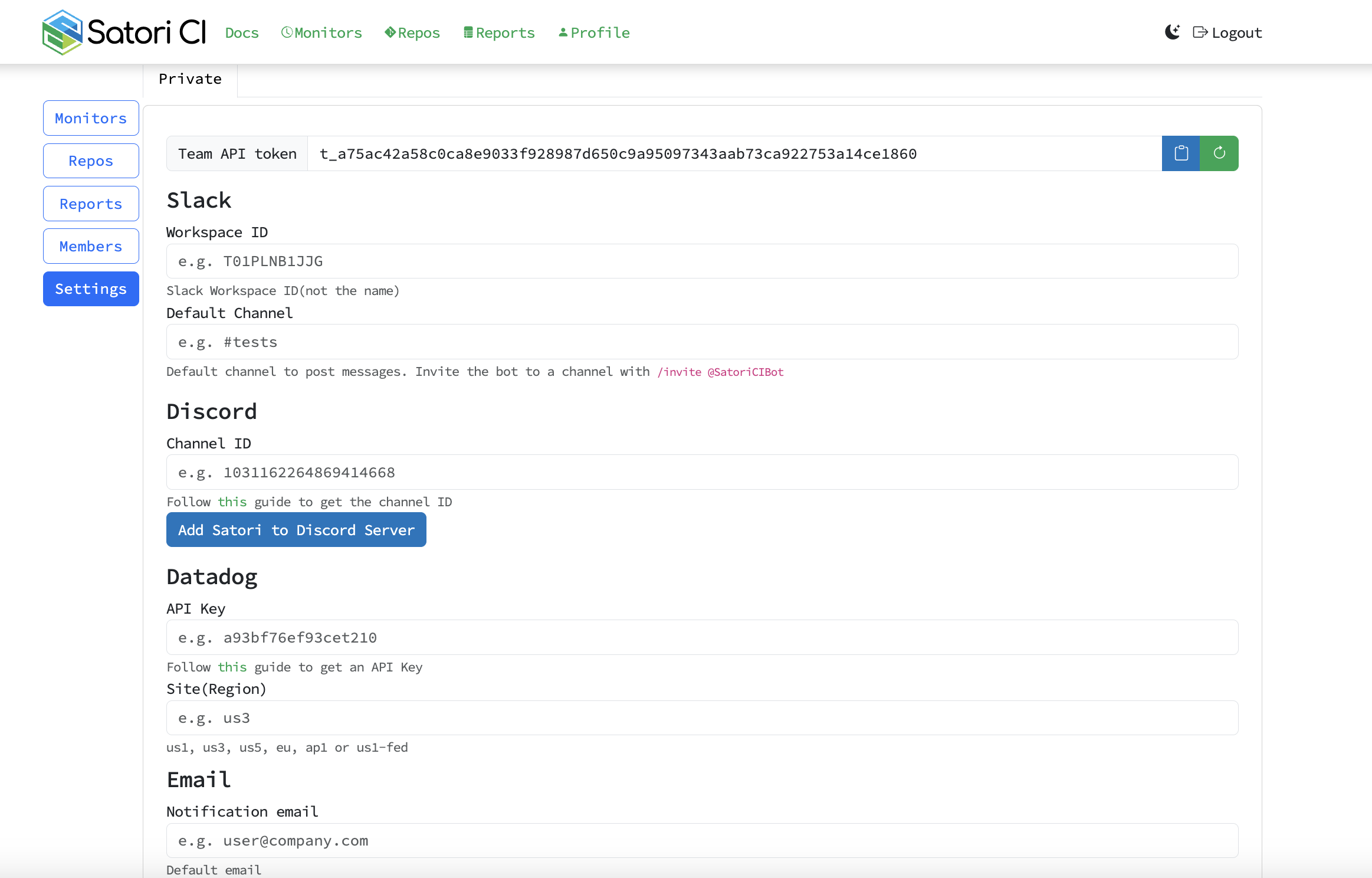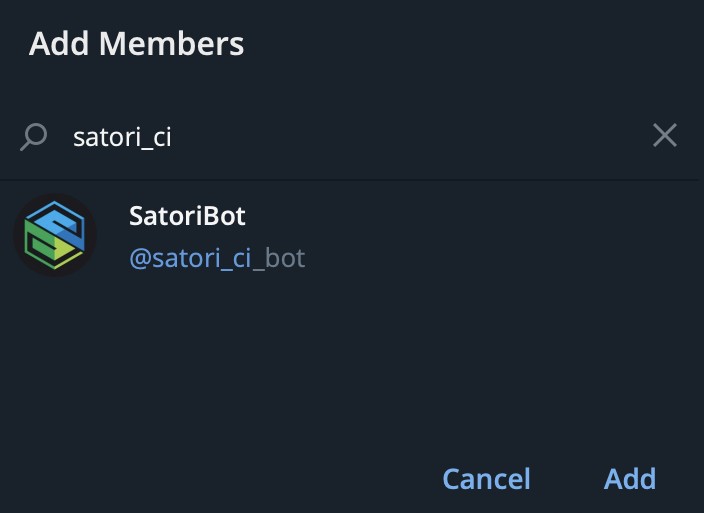Notifications
Our flexible notification system ensures that your team stays informed about the status of your projects in real-time. We offer integration with multiple communication platforms, including:
You can define the specific conditions under which you wish to receive updates—whether on test failures, successes, or both.
Notification settings
You can configure notifications using either the web interface or the CLI.
Via CLI
To view your current notification settings, run the following command:
satori team Private settings
Via Web
You can also set up notifications using the web interface by completing the necessary fields in the Notifications section of the Satori web dashboard.
- Log in to the Satori web dashboard.
- Navigate to the Team > Settings section.
- Fill in the required fields for your notification preferences (e.g., email, Slack, Discord, etc.).
- Save your settings to activate notifications for your project.

Interactive Configuration with satori settings
Satori CLI provides an interactive command to easily configure all notification settings. The command supports three modes of operation: interactive menu, viewing current configuration, and direct configuration.
Interactive Mode (Guided Setup)
The interactive mode opens a menu with step-by-step instructions for each integration:
satori settings
This command opens an interactive menu where you can:
- Set default notification method - Choose which channel (slack, discord, email, telegram, datadog) should be used by default, or disable default notifications
- Configure Datadog - Enter your Datadog API key and select your region (us1, us3, us5, eu1, ap1, ap2, us1-fed)
- Configure Discord - Add the Satori bot to your Discord server and enter the channel ID
- Configure Email - Set notification email addresses (comma-separated for multiple emails)
- Configure Slack - Authorize the Satori bot in your workspace and configure workspace/channel IDs
- Configure Telegram - Add the Satori bot to your Telegram channel and enter the channel ID
The command provides step-by-step instructions for each integration, including links to authorization pages and detailed setup guides.
View Current Settings
You can view the current value of any notification setting by providing the key name:
# View default notification method
satori settings default
# View the current value of any notification setting
satori settings KEYAvailable keys: default, datadog_api_key, datadog_site, discord, email, slack_workspace, slack_channel, telegram
Set Values Directly
You can configure notification settings directly from the command line without using the interactive menu:
# Set default notification method
satori settings default slack
# Configure email addresses
satori settings email user@example.com
# Configure Slack workspace
satori settings slack_workspace T1234567
# Configure Slack channel
satori settings slack_channel C1234567
# Configure Discord channel ID
satori settings discord 1234567890
# Configure Datadog API key
satori settings datadog_api_key abc123def456
# Configure Datadog site region
satori settings datadog_site us3
# Configure Telegram channel ID
satori settings telegram -1234567890Team-Specific Configuration
All modes support team-specific configuration using the --team flag:
# Interactive mode for a specific team
satori settings --team MyTeam
# View team settings
satori settings default --team MyTeam
# Configure team settings
satori settings email team@example.com --team MyTeam
# Alternative: using team command alias
satori team MyTeam settingsAfter configuring settings, the changes are applied immediately to your team.
Playbook Settings
To configure your notification preferences, start by defining your Playbook Settings. In this section, you can choose how you want to be notified about your tests—whether for every event (log), only on failures (logOnFail), or only on successes (logOnPass). You can specify your preferred notification channels, including email, Slack, Datadog, or Discord.
Example Configuration
You can set your notification preferences in YAML format as follows:
settings:
log|logOnFail|logOnPass: email|slack|discord|datadog
[...]For example, to receive notifications on Slack only when a test fails, you would configure your settings like this:
settings:
logOnFail: slack
[...]Configuring Notifications
Email
To set up email notifications, use this command:
satori team Private set_config notification_email your@email.com
Slack
To set up Slack notifications in Satori, follow these steps to retrieve your workspace and channel IDs:
Steps to Retrieve Workspace and Channel ID:
- Open the web version of Slack and navigate to the channel you're interested in.
- In your browser’s URL bar, you’ll see a URL like this: https://app.slack.com/client/T00000000/C00000000. The part after '/client/' is split into two segments.
- In the Satori CI dashboard, go to Team > Settings.
- Enter the first segment of the URL (e.g., T00000000) in the workspace ID field.
- Insert the Channel ID (e.g., C00000000) in the default channel field to receive notifications.
- Select Add Satori to Workspace and follow the instructions on the Slack website to add the bot.
- In Slack, invite the bot to the channel by typing
/invite @SatoriCIBot.
Or via the CLI command:
satori team Private set_config slack_workspace TXXXXXXXXXX
satori team Private set_config slack_channel CXXXXXXXXXX
Discord
To set up Discord notifications in Satori, you first need to obtain the Channel ID. Follow these steps:
Enabling Developer Mode:
- Open your Discord settings by clicking the gear icon in the bottom left corner, next to your username and avatar.
- In the settings menu, select Appearance under the App Settings category.
- Scroll down to the Advanced section and toggle on Developer Mode.
Obtaining the Channel ID:
- Right-click the desired channel name in Discord.
- Select Copy ID from the dropdown menu. The Channel ID is now copied to your clipboard. Note: This method can be used to obtain IDs for text channels, voice channels, categories, and individual messages.
Once you have the Channel ID, you can configure it in Satori Web or with the following command:
satori team Private set_config discord_channel CHANNEL_ID
Telegram
To set up Telegram notifications with Satori, follow these steps:
Create a Telegram Channel: ensure you have a Telegram channel and invite the
@satori_ci_botto your team.
Obtain the Channel ID: access your channel via the web at Telegram Web. The Channel ID is the number that appears after the # in the URL (e.g., -15050500050). Once you have the Channel ID, you can configure it in Satori-CI to start receiving notifications.

satori team Private set_config telegram_channel CHANNEL_IDDatadog
Satori-CI integrates with Datadog Events for notification management. To set this up, you'll need to create an API Key and specify the Site Region from Datadog.
Step 1: Create an API Key
- Navigate to Organization Settings in your Datadog account.
- Go to API Keys.
- Click on + New Key to create a new API key for Satori.
Step 2: Configure the API Key in Satori-CI
Use the Satori CLI to configure your newly created API key with the following command:
satori team Private set_config datadog_api_key {MyDatadogApiKey}- Replace
{MyDatadogApiKey}with your Datadog API key.
Step 3: (Optional) Configure Site Region
By default, events are sent to the us1 site region. To configure a different site region, use the following command:
satori team Private set_config datadog_site {MyDatadogRegion}- Replace
{MyDatadogRegion}with one of the following options:us1,us3,us5,eu,ap1, orus1-fed.
Via CLI with the following command:
satori team Private set_config datadog_api_key a123
satori team Private set_config datadog_site us3|eu|etc
Report notifications
To receive a copy of your test report in PDF format along with your notifications, you can specify this in your Playbook Settings.
settings:
onLogFail: slack
report: pdfIf you wish to prevent the generation of any reports, you can set the report option to false. This will ensure that all generated outputs are deleted:
settings:
onLogFail: slack
report: false